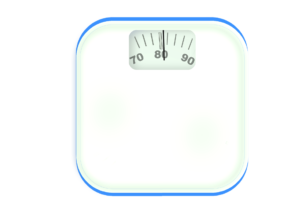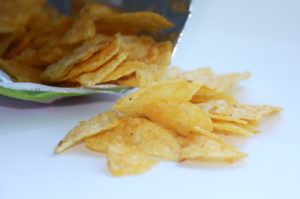Understanding and Working with Units
3 Weight Measurements
Click play on the following audio player to listen along as you read this section.
https://media.bccampus.ca/id/0_5rmhi2xp?width=608&height=402&playerId=23449753

How much do you weigh?
According to the “always correct” internet, the average Canadian man weighs 182 pounds or 82.7 kilograms and the average Canadian woman weighs 153 pounds or 69.4 kilograms.
Pounds and kilograms are just two of the ways weight can be measured. Sometimes you might hear weight referred to as mass.

Weight and mass are actually two different things but for the most part we refer to them as the same thing. Weight is a reference to the amount of force an object experiences due to the effects of gravity. If the gravitational pull changes, like if you were on the moon, your weight would change. The mass of an object would stay the same regardless of the gravitational pull of an object. The mass of an object refers to how much matter it contains. This does not change.
Whatever the case we will refer to weight and mass as the same concept.

If you want to know more about the difference between weight and mass check out the following link: Mass versus weight (Wikipedia)
The Metric System of Weight
When dealing with weight measurements in metric we follow a pattern similar to the one used for metric linear measurements. We start with the base unit which is the gram and all other metric weights have a multiplier that relates back to the gram.
Now remember with metric linear measurements there were a lot of them on that table and most of them we really didn’t deal with. Its the same thing with metric weight measurements. We won’t deal with all of them but rather just the few that we deal with the majority of the time.
So using our gram as the base unit we have:
| Unit | Multiplier |
|---|---|
| kilogram (kg) | 1,000 |
| gram (base unit) (g) | 1 |
| centigram (cg) | 0.01 |
| milligram (mg) | 0.001 |
From this chart we can conclude that there are 1000 grams in a kilogram and that there are 1000 milligrams in a gram. Once again using the multiplier we can go from one unit to the other.
Let’s throw in one other number here…the metric tonne.
[latex]\Large 1 \text{ metric tonne}= 1000 \text{ kilograms}[/latex]
Just for fun we’ll write down the metric weight of a few common (or maybe uncommon) items.
| Example | Weight |
|---|---|
| Usain Bolt (sprinter from Jamaica) | 94 kilograms |
| Hummingbird | 4 grams (average) |
| Grizzly bear | 300 kilograms (adult male average) |
| An electron | 9.109×10−31 kilograms (very light) |
| The sun | 1.989×1030 kilograms (very heavy) |
The best way for us to go about working with metric weights is to go through a few examples to get used to it.
Example

A bag of potato chips weights 48 grams. How many milligrams is that?
Step 1: Find the multiplier
What we see is that going from milligrams to grams the multiplier is 0.001. What this is saying is that a milligram is 1/1000th of a of a gram or that there are 1000 milligrams in a gram.
Step 2: Build a ratio
[latex]\Large \dfrac{1 \text{ gram}}{48 \text{ grams}} = \dfrac{1000 \text{ mg}}{\text{X mg}}[/latex]
Step 3: Cross multiply.
[latex]\Large \dfrac{1 \text{ gram}}{48 \text{ grams}} = \dfrac{1000 \text{ mg}}{\text{X mg}}[/latex]
[latex]\Large 1 \times \text{X} = 48 \times 1000[/latex]
[latex]\Large \text{x}= 48,000[/latex]
[latex]\Large \text{Answer} = 48,000 \text{ grams}[/latex]
Examples

1 cubic metre of concrete weighs 2.4 metric tonnes. How much is that in kilograms?
Step 1: Find the multiplier.
In this case if we go from a metric ton to kilograms the multiplier is 1000. What we are saying is that there are 1000 kilograms in one metric ton.
Step 2: Build a ratio
[latex]\Large \dfrac{1 \text{ tonne}}{2.4 \text{ tonnes}} = \dfrac{1000 \text{ kg}}{\text{X kg}}[/latex]
Step 3: Cross multiply
[latex]\Large \begin{array}{c}\dfrac{1 \text{ tonne}}{2.4 \text{ tonnes}} = \dfrac{1000 \text{ kg}}{\text{X kg}} \\ 1 \times \text{X} = 2.4 \times 1000 \\ \text{X} = 2,400 \\ \text{Answer} = 2,400 \text{ kilograms}\end{array}[/latex]
Practice Question
Try a practice question yourself and check the video answer to see how you did. Make sure to follow the steps outlined above and think about whether the value you should get is greater or smaller than the original value.
Question 1

Istvan is a bricklayer originally from Hungary. His specialty is building red brick houses which tend to last longer than wood frame houses and are common back in Hungary. Each brick weights about 2.7 kilograms. How many centigrams is that?

As there is no direct multiplier from kilograms to centigrams your best bet might be to do this in 2 steps. You may want to go from kilograms to grams and then from grams to centigrams.
The Imperial System of Weight
Although there is a lot of history behind the imperial system we are going to stick to the basics here.

If you would like to find out more information about the history of imperial weights check out the following link: Imperial Units (Britannica)
For our purposes we will only deal with 3 different measurements of weights in the imperial system. They are:
| Unit Name | Equivalent Values |
|---|---|
| ounce (oz) | 1/16 or 0.0625 pounds |
| pound (lb) | 16 ounces |
| ton | 2000 pounds |
Okay, we’ll throw one more in there and that is a “stone.” It’s a term you may hear once in a while and certainly much more common in Britain than in Canada. A stone is 14 pounds. The stone as a form of measurement developed many years ago and dealt with weight when people were trading goods. Originally a “stone” could have been anywhere from 5 to 40 pounds but now it’s stabilized at 14 pounds.
And another thing……that ton that you see in this table is different than the metric equivalent. First the spelling is different. There is the metric “tonne” and the imperial “ton.” Second there is the actual weight. A metric tonne weighs 1000 kilograms while an imperial ton weighs 2000 pounds. And that’s not all! 2000 pounds is referred to as a “short” ton while a “long” ton is around 2400 pounds.
Once again here are those items from before just with weights that are now in imperial.
| Example | Weight |
|---|---|
| Usain Bolt (sprinter from Jamaica) | 206.8 pounds |
| Hummingbird | 0.14 ounces (average) |
| Grizzly bear | 660 pounds (adult male average) |
| An electron | 2 ×10−30 pounds (still light) |
| The sun | 4.385 ×1030 pounds (still heavy) |
Now let’s go through a few examples working between the imperial units for weight.
Example

A typical 4’ × 8’ sheet of plywood 3/4″ thick weighs approximately 61 pounds. How many ounces is that?
Step 1: Find the number that states the relationship between pounds and ounces. Remember that we are going from pounds to ounces.
In this case if we go from pounds to ounces the number we would use is 16. What we have is that one pound is equal to 16 ounces.
Step 2: Build a ratio.
[latex]\Large \dfrac{1 \text{ pound}}{61 \text{ pounds}}= \dfrac{16 \text{ ounces}}{\text{X ounces}}[/latex]
Step 3: Cross multiply
[latex]\Large \begin{array}{c} \dfrac{1 \text{ pound}}{61 \text{ pound}}= \dfrac{16 \text{ ounces}}{\text{X ounces}} \\ 1 \times \text{X} = 61 \times 16 \\ \text{X} = 976 \\ \text{Answer} = 976 \text{ ounces}\end{array}[/latex]
We’ll go through another example but in this case we’ll add a little more to the question.
Examples

A piece of 2 × 4 wood weighs about 25.6 ounces per foot. A house is being framed and an order goes in for 103 eight foot lengths of 2 × 4. What will be the total weight of the wood in pounds?
Step 1: Find the total amount of wood required in the order in feet.
[latex]\Large \begin{array}{c} \text{Feet}= \text{pieces} \times 8 \text{ feet/piece} \\ \text{Feet}= 103 \times 8 \\ \text{Feet}= 824 \end{array}[/latex]
Step 2: Find the total weight of the wood in ounces.
[latex]\Large\begin{array}{c} \text{ounces}= \text{feet} \times 25.6 \text{ ounces/foot} \\ \text{ounces}= 824 \times 25.6 \\ \text{ounces}= 21,094\end{array}[/latex]
Step 3: Find the number that works between ounces and pounds remembering that we are going from ounces to pounds.
In this case 1 ounce = 1/16 or 0.0625 pounds
Step 4: Build a ratio
[latex]\Large \dfrac{1 \text{ oz}}{21,094 \text{ oz}}= \dfrac{0.0625 \text{ lbs}}{\text{X lbs}}[/latex]
Step 5: Cross multiply
[latex]\Large\begin{array}{c} \dfrac{1 \text{ oz}}{21,094 \text{ oz}}= \dfrac{0.0625 \text{ lbs}}{ \text{X lbs}} \\ 1 \times \text{X} = 21,094 \times 0.0625 \\ \text{X} = 1318.38 \\ \text{Answer} = 1318.38 \text{ lbs}\end{array}[/latex]
Practice Question
Try a practice question yourself and check the video answer to see how you did. Make sure to follow the steps outlined above and think about whether the value you should get is greater or smaller than the original value.
Question 1

We’re going to go back to Istvan, our bricklayer. Istvan needs to buy some brick mortar when building the house. He buys 0.15 tons of mortar for the job. How much is this in pounds?
Working between Metric and Imperial Weight Measurements
We’re going to do the same thing in this part as we did in the linear measurement part and only deal with a few of the most common weight measurements in imperial and metric. Once again the units from metric that are translated into imperial and then back the other way are units that represent similar weight categories. For instance a metric tonne would be similar to an imperial ton.
Below are the numbers to translate from metric to imperial and them from imperial back to metric.
| Metric | Imperial Equivalent |
|---|---|
| kilogram (kg) | 2.2 pounds |
| gram (g) | 0.035 ounces |
| tonne | 2200 pounds |
| Imperial | Metric Equivalent |
|---|---|
| pound (lb) | 0.454 kilograms |
| ounce (oz) | 28.35 grams |
| ton | 909 kilograms |
Let’s just get right into the examples here.
Example

The Lincoln SA200 is a type of welding machine. In fact it’s a pretty heavy welding machine that weighs about 410 pounds. How much would this be in kilograms?
Step 1: Find the number that translates between kilograms and pounds. Remember that we are going from pounds to kilograms. We know that 1 pound equals 0.454 kilograms.
Step 2: Build a ratio
[latex]\Large \dfrac{1 \text{ lb}}{410 \text{ lbs}}= \dfrac{0.454 \text{ kg}}{\text{X kg}}[/latex]
Step 3: Cross multiply
[latex]\Large\begin{array}{c} \dfrac{1 \text{ lb}}{410 \text{ lbs}}= \dfrac{0.454 \text{ kg}}{\text{X kg}} \\ 1 \times \text{X}= 410 \times 0.454 \\ \text{X}= 186.14 \\ \text{Answer}= 186.14 \text{ kg}\end{array}[/latex]
Example

Slavka is a baker who works for a bakery located in a small town in the interior of British Columbia. One of the big sellers at this particular bakery is the fresh cooked European style crusty bread. Each loaf of bread requires about 10.6 ounces of flour. As Slavka has a Czech background she wants to translate that into grams. How many grams of flour does it take to bake one loaf of bread?
Step 1: Find the number that translates between ounces and grams. Keep in mind that we are going from ounces to grams in this case. We know that one ounce equals 28.35 grams
Step 2: Build a ratio
[latex]\Large \dfrac{1 \text{ oz}}{10.6 \text{ oz}}= \dfrac{28.35 \text{ g}}{\text{X g}}[/latex]
Step 3: Cross multiply
[latex]\Large\begin{array}{c} \dfrac{1 \text{ oz}}{10.6 \text{ oz}}= \dfrac{28.35 \text{ g}}{\text{X g}} \\ 1 \times \text{X}= 10.6 \times 28.35 \\ \text{X}= 300.51 \\ \text{Answer}= 300.51 \text{ g}\end{array}[/latex]
Example

Just for fun let’s add another layer to this question. How many loaves of bread could Slavka make if she started with a 10 pound bag of flour?
Step 1: Change the 10 pounds into grams. Find a number that translates between the two.
Looking back at our table we find that we don’t have a number that translates from pounds into grams. We do have a number that translates from pounds into kilograms though. We’ll start with that.
We see that 1 pound = 0.454 kilograms.
We also see that 1 kilogram = 1000 grams.
We can use both these numbers to calculate the number of grams.
Step 2: Build a ratio from pounds into kilograms and cross multiply.
[latex]\Large \begin{array}{c} \dfrac{1 \text{ lb}}{10 \text{ lbs}}= \dfrac{0.454 \text{ kg}}{\text{X kg}} \\ 1 \times \text{X}= 10 \times 0.454 \\ \text{X}= 4.54 \\ \text{Answer}= 4.54 \text{ kg}\end{array}[/latex]
Step 3: Translate kilograms into grams.
[latex]\Large\begin{array}{c}\dfrac{1 \text{ kg}}{4.54 \text{ kg}}= \dfrac{1000 \text{ g}}{\text{X g}} \\ 1 \times \text{X}= 4.54 \times 1000 \\ \text{X}= 4540 \\ \text{Answer}= 4540 \text{ g}\end{array}[/latex]
Almost there!!!!
Step 4: Take the number of grams in a 10 pound bag of flour and divide it by the number of grams of flour it takes to make one loaf of European crusty bread.
[latex]\Large \begin{array}{rcl} \text{loaves of bread}& = & \dfrac{\text{grams in a 10 pound bag of flour}}{\text{grams in loaf of bread}} \\ & = & \dfrac{4540}{300.5} \\ & = & \text{15.10 loaves of bread}\end{array}[/latex]
Using our rounding skills developed in the earlier chapters we would round that down to 15 loaves. In fact, due to loss and waste during the bread making process we could assume that we would make even less loaves that that.
Practice Question
Try a practice question yourself and check the video answer to see how you did. Make sure to follow the steps outlined above and think about whether the answer you should get is greater or smaller than the original value.
Question 1
 Keeping with food we’ll move our attention over to cooking where Francois is cooking up a fish weighing 4 pounds 6 ounces. What is the weight of the fish in grams?
Keeping with food we’ll move our attention over to cooking where Francois is cooking up a fish weighing 4 pounds 6 ounces. What is the weight of the fish in grams?

Once again you’ll have to do this in two steps. Do it however you wish but think of the most efficient way to do it.
Hint: What is the imperial measurement of weight which corresponds to grams?

